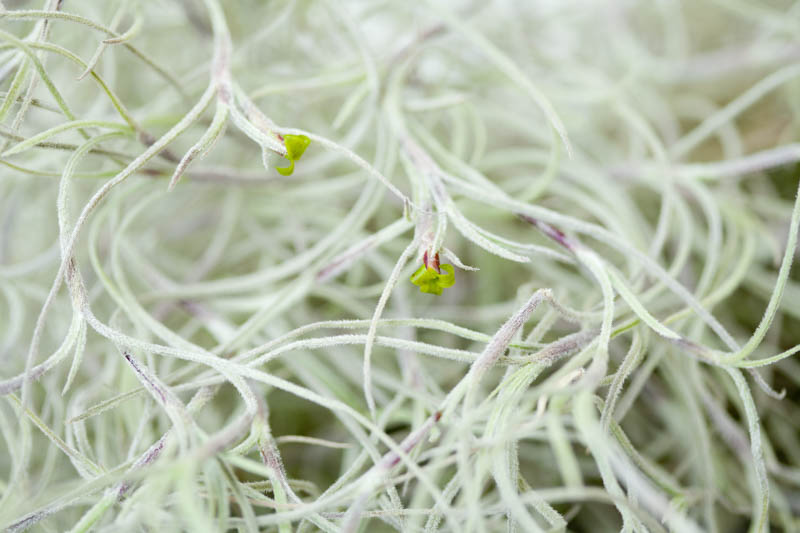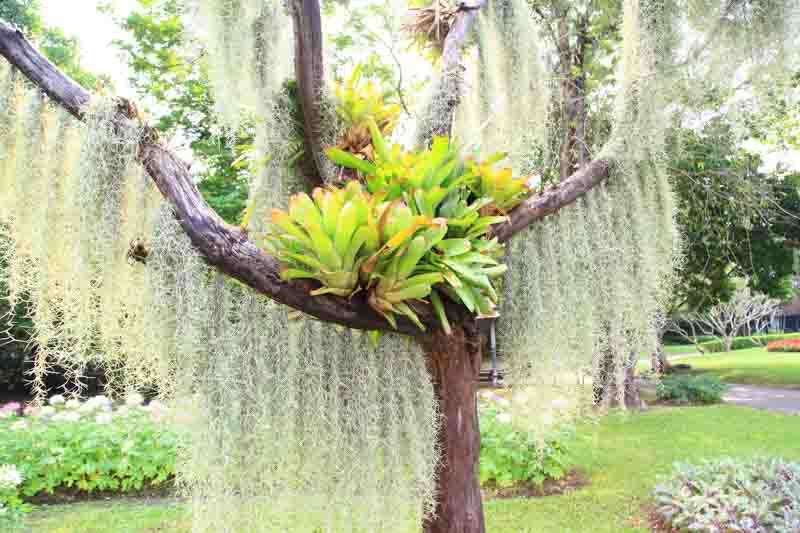Air Plant, Grandfather's Whiskers, Graybeard, Long Moss, Old Man's Beard, Spanish Moss, Wool Crepe, Black Moss, Florida Moss, Gray Moss, Hanging Moss, Long Beard, New Orleans Moss, Southern Moss, Tree Beard, Vegetable Hair
Tillandsia usneoides, commonly known as Spanish Moss, is a distinctive and iconic air plant that drapes over tree branches, creating captivating natural sceneries primarily in the southeastern United States.
Spanish Moss is an epiphytic perennial (grows on trees) showcasing a cascading or draping growth habit. It features slender, thread-like stems covered with scale-like, silver-gray leaves. This gives the plant a ghostly, beard-like appearance as it hangs from tree branches.
Native: Native to the southeastern United States, Central America, South America, and the Caribbean, Spanish Moss thrives in humid, warm climates. It is particularly prevalent in the deep South of the United States, where it adorns live oaks and bald cypresses in picturesque Spanish moss-draped landscapes. Spanish Moss belongs to the bromeliad family (Bromeliaceae), along with the pineapple or the urn plant.
Plant Type and Habit: Spanish moss is an air plant that does not require soil to grow. Instead, it absorbs nutrients and moisture directly from the air through its leaves, making it an exemplary model of adaptation and survival.
Size: Individual strands of moss can grow quite long, up to 20 feet (6 meters). In ideal conditions, it can form dense, extensive mats that hang in striking curtains from tree limbs.
Flowers: Spanish Moss produces small, inconspicuous flowers that are generally pale green or blue. These flowers are known for their delightful fragrance, especially during the evening. Flowering typically occurs in spring and early summer, though it can vary depending on the climate and growing conditions. After flowering, it produces tiny seed pods. When the pods burst open, they release seeds equipped with fine, hair-like structures that aid in wind dispersal.

Foliage: The plant’s foliage, consisting of scaly, silver-gray leaves, is specially adapted to capture moisture and nutrients from the air, showcasing its efficiency in its epiphytic lifestyle.
Hardiness: Tillandsia usneoides is hardy in USDA zones 8 through 11. It is highly tolerant of various environmental conditions but thrives best in high humidity and with adequate air circulation.
Uses: Historically, Spanish Moss has been used for various purposes, including building insulation, mulch, mattress stuffing, and even as material for arts and crafts. Its ethereal beauty also makes it a popular decorative element in floral arrangements and garden designs.
Wildlife: Spanish Moss provides habitat and nesting material for wildlife, including birds and bats. Its dense growth can offer shelter and nesting sites, contributing to biodiversity in its native habitats.
Toxicity: Spanish Moss is not toxic to humans or animals, making it a safe addition to landscapes and gardens.
There are a couple of popular theories explaining the origin of its name:
European Colonization Era Origin: One theory suggests that the name “Spanish Moss” originated from French settlers in the southeastern United States during the early periods of European colonization. They thought the plant’s appearance resembled the beards of the Spanish conquistadors, who were their rivals at the time. Thus, they called it “Barbe Espagnol,” or “Spanish Beard.” Over time, this term possibly evolved into “Spanish Moss.”
Native American Lore: Another theory ties the name to a Native American story. The tale describes a Spanish explorer who fell in love with a native chief’s daughter. When they tried to escape together, they were caught, and the explorer was killed, hanging from a tree. His long, gray beard continued to grow after death, spreading from tree to tree. This story, whether true or not, might have influenced the plant’s common name by associating it with the “Spanish” element of the tale.

Bromeliad and Spanish Moss on Tree
Spanish Moss is not just a visually intriguing plant; it offers several ecological and practical benefits.

Male Osprey bringing nesting material (Spanish Moss) back to his huge nest.
Growing and caring for Spanish Moss is relatively straightforward, thanks to its minimal requirements and adaptive nature.

Live oak trees in Georgia
Propagating Spanish Moss is remarkably straightforward, thanks to its naturally adaptive growth and survival mechanisms. Here’s how you can easily propagate Spanish Moss:
Spanish Moss, while generally resilient and free of many pests that afflict other plants, can occasionally host a few pests. These include:
Chiggers: Chiggers, or red bugs, are tiny larvae of mites that are often mistakenly thought to inhabit Spanish Moss. While chiggers can be found in many outdoor environments, they are not specific to Spanish Moss but may be present in the same areas where the moss thrives. Chiggers themselves do not damage the moss but can cause irritating bites on humans who come into contact with infested areas.
Scale and Mealybugs: These sap-sucking insects can sometimes be found on Spanish Moss, feeding on its juices. They generally do not cause significant harm to the moss but can weaken it over time by reducing its vigor.
Spider Mites: These tiny pests can infest Spanish Moss, especially if it’s grown in dry, hot conditions. They suck sap from the plant, which can lead to discoloration and weakening of the moss if the infestation is severe.
Drying Out: If the moss turns brittle or gray, it may not receive enough moisture. Increase the frequency of misting, especially in dry, hot weather. If it’s severely dehydrated, consider soaking the moss in water for a few hours, then hanging it back up to dry slightly before placing it in its permanent spot.
Sunburn: While Spanish Moss enjoys bright light, direct sunlight can scorch its leaves, causing them to turn brown or bleach out. Move the moss to a location where it receives filtered or indirect light to avoid further damage.
Nutrient Deficiency: Being an air plant, Spanish Moss doesn’t rely heavily on soil nutrients, but a lack of essential nutrients can inhibit its growth. You can lightly mist the moss with a diluted liquid fertilizer (specifically formulated for air plants or bromeliads) once a month during the growing season to provide additional nutrients.
Yes, Spanish Moss has several uses:
Spanish Moss is not parasitic but epiphytic, meaning it grows on trees for physical support without taking nutrients from them. It absorbs moisture and nutrients from the air and rainfall. While it can grow extensively and potentially cover a tree’s foliage, it typically does not harm healthy trees. However, if it becomes excessively dense, it might slightly impact a tree’s photosynthesis by blocking sunlight.
In its native habitat, Spanish Moss is not considered invasive. It coexists as part of the ecosystem. Problems might arise when it’s introduced to non-native environments where it could potentially grow unchecked, but this is generally rare.
There are a few reasons why someone might choose to remove Spanish Moss:
While Spanish Moss can grow on many trees, it prefers certain conditions and hosts. It thrives on trees with rough, furrowed bark, providing better anchoring support. In the southern United States, Spanish Moss exhibits a notable affinity for the southern live oak (Quercus virginiana) and bald cypress (Taxodium distichum), drawn to these trees by their high levels of foliar mineral leaching. This process releases calcium, magnesium, potassium, and phosphorus, providing a rich nutrient source for the moss. Although these trees are preferred, Spanish Moss can also grow on a variety of other trees, including sweetgum (Liquidambar styraciflua), crepe myrtles (Lagerstroemia spp.), additional oak species, and even pines.
| Hardiness |
8 - 11 |
|---|---|
| Plant Type | Houseplants, Perennials |
| Plant Family | Bromeliaceae |
| Exposure | Partial Sun |
| Season of Interest |
Spring (Early, Mid, Late) Summer (Early, Mid, Late) Fall Winter |
| Characteristics | Showy, Evergreen |
| Native Plants | United States, Maryland, Southeast, Louisiana, Mississippi, North Carolina, South Carolina, Virginia, Alabama, Arkansas, Florida, Georgia, Southwest, Texas |
| Hardiness |
8 - 11 |
|---|---|
| Plant Type | Houseplants, Perennials |
| Plant Family | Bromeliaceae |
| Exposure | Partial Sun |
| Season of Interest |
Spring (Early, Mid, Late) Summer (Early, Mid, Late) Fall Winter |
| Characteristics | Showy, Evergreen |
| Native Plants | United States, Maryland, Southeast, Louisiana, Mississippi, North Carolina, South Carolina, Virginia, Alabama, Arkansas, Florida, Georgia, Southwest, Texas |
How many Tillandsia usneoides (Spanish Moss) do I need for my garden?
| Plant | Quantity | |
|---|---|---|
| Tillandsia usneoides (Spanish Moss) | N/A | Buy Plants |
Create a membership account to save your garden designs and to view them on any device.
Becoming a contributing member of Gardenia is easy and can be done in just a few minutes. If you provide us with your name, email address and the payment of a modest $25 annual membership fee, you will become a full member, enabling you to design and save up to 25 of your garden design ideas.
Join now and start creating your dream garden!
Create a membership account to save your garden designs and to view them on any device.
Becoming a contributing member of Gardenia is easy and can be done in just a few minutes. If you provide us with your name, email address and the payment of a modest $25 annual membership fee, you will become a full member, enabling you to design and save up to 25 of your garden design ideas.
Join now and start creating your dream garden!